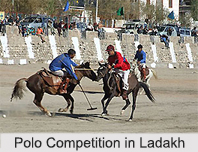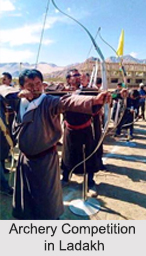 Polo and archery are generally classified as the traditional sports in Ladakh. Enjoyed by the masses, these sports are closely associated with ancestry in Ladakh. Both these games are mostly played during summer. It is interesting to note that in some of the remotest areas of Ladakh, like, Nagar, Baltistan, Chitral, Hunza and Gilgit, people are ardent fans of Polo. Polo is a game that is generally associated with the royals in India. But in Ladakh it is popular as a traditional sport.
Polo and archery are generally classified as the traditional sports in Ladakh. Enjoyed by the masses, these sports are closely associated with ancestry in Ladakh. Both these games are mostly played during summer. It is interesting to note that in some of the remotest areas of Ladakh, like, Nagar, Baltistan, Chitral, Hunza and Gilgit, people are ardent fans of Polo. Polo is a game that is generally associated with the royals in India. But in Ladakh it is popular as a traditional sport.
Method of Archery in Ladakh
Archery is a traditional sport in Ladakh and has been stated in various national epics also. Even today the people of Ladakh idolize the legendary hero Darpon Chemo, who was the great archer of the kesar sagar. Archery shooting competition takes place by separating the participants into two groups with one captain each. They have to shoot at the "isa ga" or the "bull"s eye" at the competition. When one hits the bull`s eye, his partner offers `khatak` or white scarf to him. He has to lead a dance at the end of the round of shooting. This game is conducted with proper etiquette with the accompaniment of the music of surna and daman- Shehnai and Drum.
 Archery in Ladakh is a vital component in the performance of cultural, social and traditional activities of Ladakh. Since it`s a traditional sport, it has been inherited from generation to generation, and today the young generation is pursuing this sport as their carrier showing great skill and performance.
Archery in Ladakh is a vital component in the performance of cultural, social and traditional activities of Ladakh. Since it`s a traditional sport, it has been inherited from generation to generation, and today the young generation is pursuing this sport as their carrier showing great skill and performance.
Method of Polo in Ladakh
Ladakh region is also famous for Polo. It is speculated that the sport came down to this region from Central Asia. Though the rest of Indian Polo is the Raja"s game, survived for ages in the northeastern parts of the country, in Ladakh it is the traditional sport of this region. Here the players throw the ball between the posts and the goal is awarded. The players are on horseback but there are no chukkers. Each half of the game ends when either of the team scores nine goals. The goals are fixed on the both end of the streets. The team strength depends on the number of good players available for a particular team. The only foul is awarded when a player cuts the path of another player. Other than this, there are no fixed rules for Polo in Ladakh. Polo is mostly popular in Baltistan and Gilgit. This sport was introduced into Ladakh in the mid 17th century by King Sinnge Namgyal; his mother was a Balti princess. This game is also played widely in the Leh district.
The traditional sports of Ladakh add a different tint in the lives of the Ladakhis who consider the sports as important festival. The sports are played by the local people of Ladakh with great gusto. Triumph and failure are emotionally perceived by the people who are closely attached to it.



















